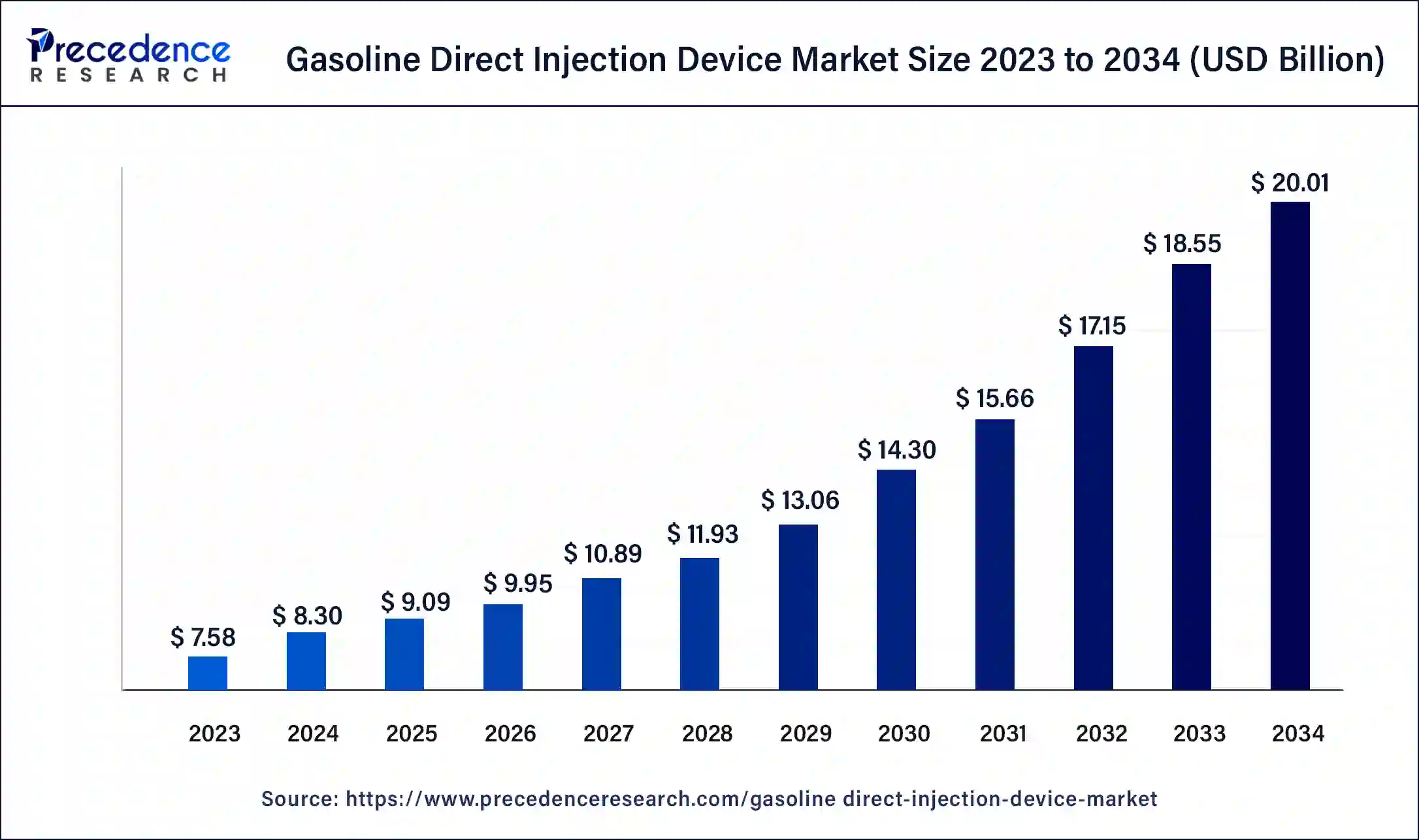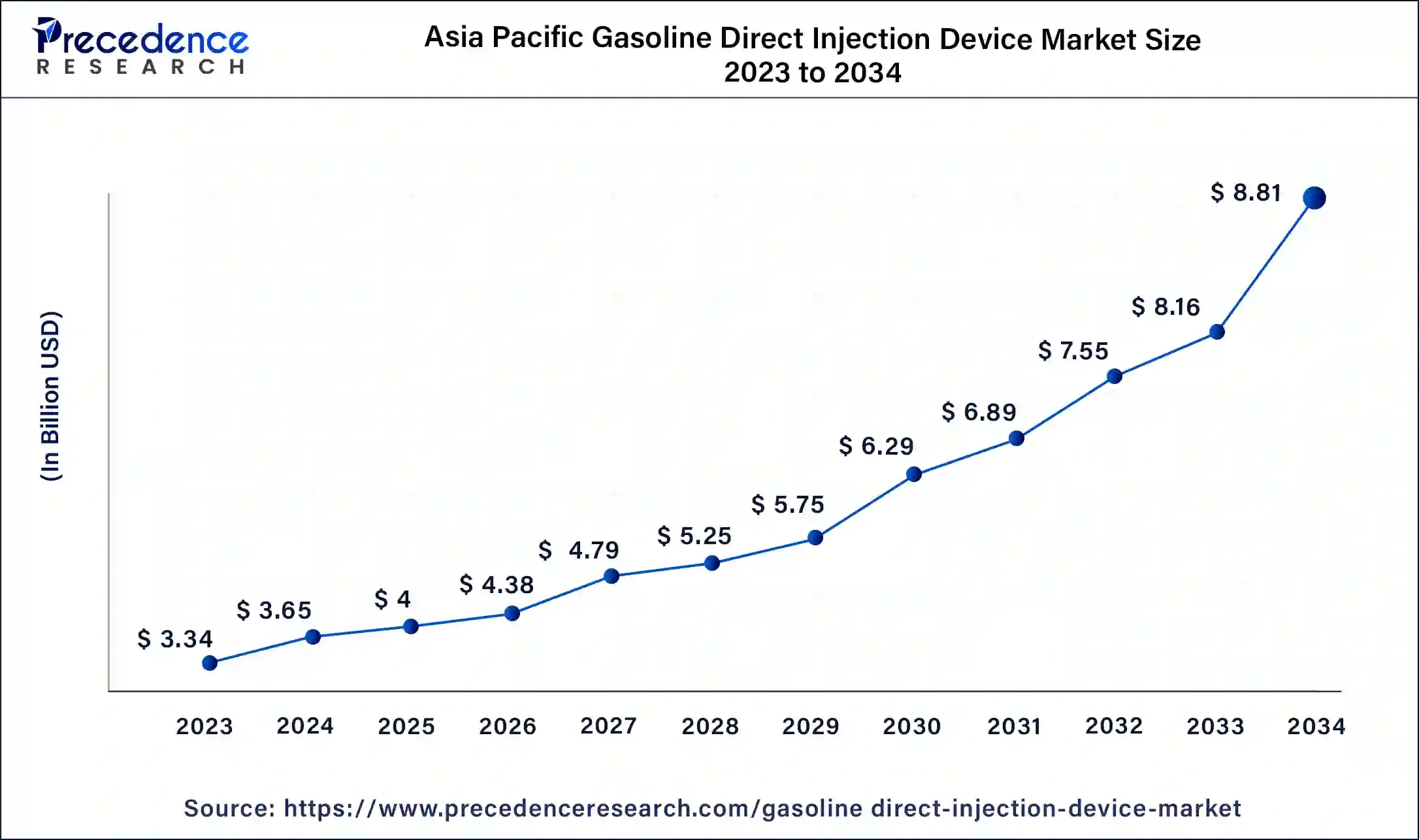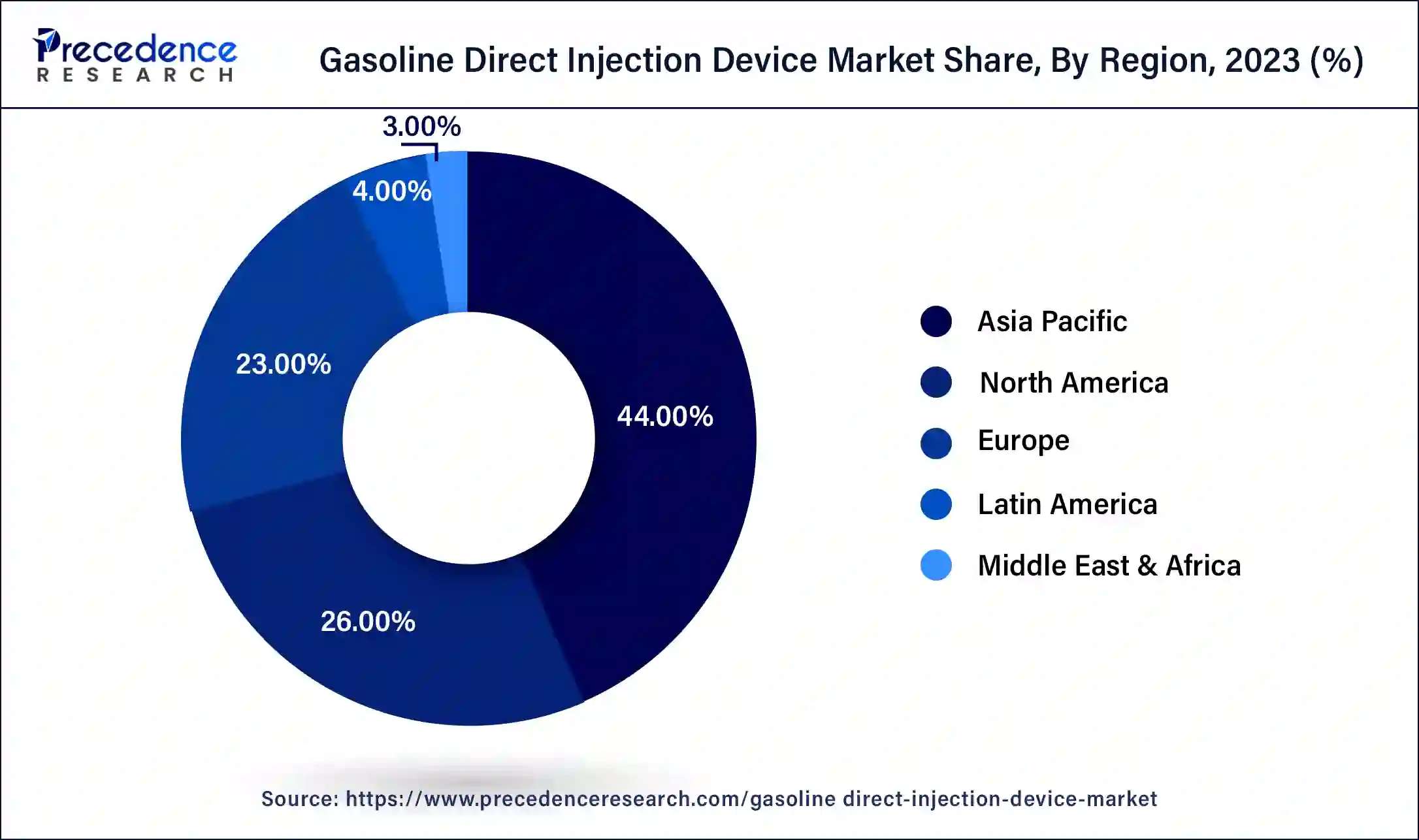September 2024
The global gasoline direct injection device market size is accounted at USD 9.09 billion in 2025 and is forecasted to hit around USD 20.01 billion by 2034, representing a CAGR of 9.20% from 2025 to 2034. The market sizing and forecasts are revenue-based (USD Million/Billion), with 2024 as the base year.
The global gasoline direct injection device market size was estimated at USD 8.30 billion in 2024 and is predicted to increase from USD 9.09 billion in 2025 to approximately USD 20.01 billion by 2034, expanding at a CAGR of 9.20% from 2025 to 2034.

The Asia Pacific gasoline direct injection (GDI) device market size was valued at USD 3.65 billion in 2024 and is expected to reach USD 8.81 billion by 2034, growing at a CAGR of 10% from 2024 to 2034.

Asia Pacific led the global GDI device market due to the increased focus of automotive market players towards untapped opportunities in the region. Further, shifting consumer trends towards vehicles with superior fuel efficiency are anticipated to spur industry growth during the projected period. Government authorities are taking strict measures to control the carbon footprint including fuel economy standards and engine upgrades.

Europe region is expected to register the highest growth over the forthcoming years pertaining to the stringent norms for fuel efficiency and emission targets. OEMs are prominently adopting GDI systems to achieve compliance standards. The significant presence of automotive players including BMW AG, Daimler AG, and Audi AG in the region is projected to positively impact the growth of the GDI system over the analysis timeframe.
Increasing motorized mobility along with rising consumer preferences for fuel efficient vehicles expected to escalate the Gasoline Direct Injection (GDI) device market size over the forecast period. Increasing demand for regulating pollution levels related to greenhouse gases coupled with improving the air quality are the key factors propelling the adoption of vehicles incorporated with the advanced fuel injection systems.
Improved engine performance together with high thermal efficiency that significantly assists in reducing the fuel emissions prominently supports the growth of the GDI industry. Rising inclination of manufacturers towards vehicle efficiency and engine downsizing anticipated to augment the market share. In addition, multiple financing firms for passenger vehicles together with increasing individual spending projected to considerably boost the adoption of GDI devices.
| Report Highlights | Details |
| Market Size in 2034 | USD 20.01 Billion |
| Market Size in 2025 | USD 9.09 Billion |
| Market Size by 2024 | USD 8.30 Billion |
| Growth Rate from 2024 to 2034 | CAGR of 9.20% |
| Dominating Region | Asia Pacific |
| Fastest Growing Region | Europe |
| Base Year | 2024 |
| Forecast Period | 2025 to 2034 |
| Segments Covered | Product, Application, Region |
| Regions Covered | North America, Europe, Asia-Pacific, Latin America, and Middle East & Africa |
Fuel injectors anticipated to witness prominent growth over the analysis period owing to need for precise control over fuel injection to ensure complete combustion of fuel. In addition, need for effective controlling of air-fuel mixture along with exhaust emissions in the gasoline engine predicted to escalate the growth of the segment over the forecast timeline. Further, the fuel injector assists in monitoring the fuel regulator that helps in maintaining the fuel pressure of delivery pipe at a constant level.
On the other side, the Electronic Control Unit (ECU) segment projected to witness significant growth in the Gasoline Direct Injection (GDI) device market due to the flexible multiple input and output channels that enhances the signal transfer within the vehicle system components. High control along with mapping the status of automotive components as well as vehicle performance on the basis of selected system inputs expected to flourish the growth of the segment.
Companies involved in the manufacturing of automotive ECU are significantly engaged in new product launch that improves the reliability and functions to cater the rising customer demand. For instance, in September 2018, Delphi Technologies introduced generation 7 electronic controllers used particularly in commercial vehicles that include trucks, buses, and off-highway vehicles. The new product enables extreme flexibility provided with multiple applications that supports the user requirements.
Passenger cars leads the gasoline direct injection device market in terms of revenue because of rising inclination of consumers towards luxury & premium cars especially in developed countries coupled with implementation of direct injection systems in those vehicles. Escalating demand for passenger cars together with the introduction to stringent emission norms for such vehicles expected to further impel the penetration of passenger cars over the analysis period. Consistent developments in the passenger vehicles owing to implementation of new functions for comfort and vehicle safety anticipated to propel the growth of the segment in the coming years.
Besides this, the commercial vehicle segment projected to witness a steady growth due to the rising road transportation along with domestic trading activities across the world. Heavy and medium commercial vehicles that operate on diesel contribute significantly towards the vehicular emissions and thus necessitate the implementation of gasoline powered engines for curtailing the environmental impact. Commercial vehicles also require highly durability and long-lasting engines that boosts the installation of GDI devices for enhanced reliability. Further, rising research & development (R&D) activities along with integration of advanced technologies in GDI devices anticipated to positively influence the growth of the segment over the forecast timeframe.
The global GDI device industry seeks significant new product launch, development, and enhancement that turn the market into competitive. This approach from industry players helps them to increase their consumer base. For instance, in July 2019, Xtreme-DI introduced GDI high-flow fuel injectors that offer more than 45% of additional fuel flow compared to stock products. The aftermarket injectors deliver outstanding and consistent performance by offering compatible injection pressures as that of the OEM equipment.
Furthermore, the market players are majorly focused on establishing long term contract for supplying specific vehicle model along with designing customized solutions for commercial and passenger vehicles this in turn will strengthen their footprint in the global market.
This research study comprises complete assessment of the market by means of far-reaching qualitative and quantitative perceptions, and predictions regarding the market. This report delivers classification of marketplace into impending and niche sectors. Further, this research study calculates market size and its development drift at global, regional, and country from 2024 to 2034. This report contains market breakdown and its revenue estimation by classifying it based on component, application, and region:
By Component
By Application
By Regional Outlook
For inquiries regarding discounts, bulk purchases, or customization requests, please contact us at sales@precedenceresearch.com
No cookie-cutter, only authentic analysis – take the 1st step to become a Precedence Research client
September 2024
July 2024
July 2024
July 2024